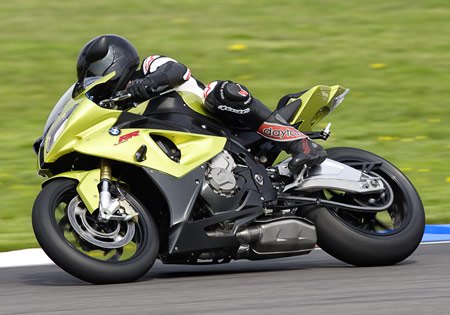2009 BMW S1000RR World Introduction - Motorcycle.com
BMW took the official wraps off its new literbike contender, the S1000RR, at the legendary Monza Racing Circuit last weekend in conjunction with an Italian round of the World Superbike Championship.
Although we already teased you with some details that have trickled out about the bike in our A Closer Look article, we now have been given full details about BMW’s new Superbike contender.
The pertinent numbers are a claimed 193 horsepower (at the crankshaft) and a 403.5-lb claimed dry weight. In a ready-to-ride form including fuel, BMW says to expect 450 lbs of weight. DTC Dynamic Traction Control is an appealing option, as is the Race ABS that adds just 5.3 lbs to the bike’s weight. Also innovative is the RR’s variable-length intake tracts that work in harmony with a 14,200-rpm redline, the highest among its rivals.
BMW didn’t try to break any new ground in choosing an inline-Four engine with an aluminum frame for the S1000RR. In its foray into the highly competitive literbike market, the German manufacturer followed the tried and tested model that has proven so successful for its Japanese competitors.
BMW did employ technology from its Formula 1 program into the S1000RR’s cylinder head. The S1000RR’s four extra-light titanium intake and exhaust valves per cylinder are operated by equally light single cam followers. According to BMW, the cam followers weigh 11 grams (0.388 ounces), almost 50% lighter than what BMW uses in its K-series motorcycles. BMW says the light and tiny cam followers gave their engineers more freedom in choosing ideal valve lift curves to optimize performance.
A short sprocket driving the camshaft through an intermediate gear helps the S1000RR’s engine help provide what BMW promises to be “supreme revving qualities at highest speeds as well as exact maintenance of valve timing with very compact dimensions”.
The S1000RR also features a cylinder bore of 80mm, which is larger than the 74.5mm bore found on the Suzuki GSX-R1000, 76mm bore found on the Honda CBR1000RR and Kawasaki ZX-10R and the 78mm bore in Yamaha’s YZF-R1.
BMW says the S1000RR’s engine has a maximum output of 193 horses at 13,000 rpm and maximum torque of 82.5 lb-ft at 9,750 rpm. The engine is said to weigh 131.8 lbs.
The S1000RR’s exhaust works on the 4-in-2-in-1 principle: four individual manifolds of equal length join into two pipes beneath the engine block before again merging into a single large-volume pre-silencer. Fully controlled interference pipes housed in the two connection pipes. The two connection pipes each house fully controlled interference pipe butterflies which open or close to moderate exhaust flow. BMW says the system provides a “homogenous” power and torque curve.
BMW also tried to make the S1000RR as light as possible to maximize power to weight ratio. The S1000RR has a claimed dry weight of 403 lb (and 450 lb wet), for a power-to-weight ratio of 1.05 (hp per kilogram), but we’ll see how it measures up when we get our hands on it.
BMW will offer Antilock Brake System and Dynamic Traction Control options for the S1000RR. The “Race ABS” system was developed for both the road and the track, and its components are said to add just 5.3 lb to the bike’s overall weight. The DTC works in conjunction with ABS and offers four modes, Rain, for wet conditions, Sport, for regular road use, Race for track use, and Slick for racing with slicker tires. The Rain mode limits power to 77%, while Slick mode disables the ABS on the rear wheel and turns off the bike’s “Wheelie Protection”.
BMW is also offering its HP Gearshift Assistant for clutchless up-shifting without interrupting torque or power as an option.
Ergonomically, BMW promises a slender, compact dimensions with the S1000RR. The tank section has the width of a 600cc supersport while the swingarm features an eccentric pivot to adjust the rear height of the S1000RR.
BMW made suspension adjustments simple by marking the settings on the upside-down fork and spring strut on a 1 to 10 scale. Instead of counting off clicks to adjust rebound, all you have to do is remember what number you want.
The S1000RR should be available some time in the fall, but we will provide a closer look at BMW’s new Superbike soon.
Discuss more at BMW S1000RR Forum.
Related Reading
2009 BMW S1000RR – A Closer Look
2009 BMW S1000RR Preview
More by Staff































Comments
Join the conversation